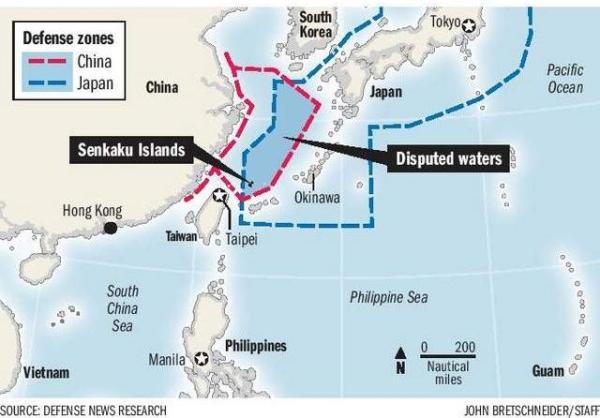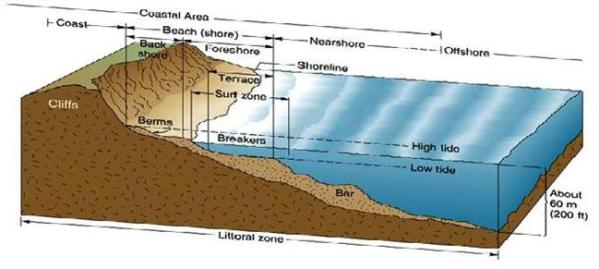Inshore surveillance – the new X-Craft ?
Robotic mini-subs
By Robert Whiston FRSA
under construction
Of far more interest than the Chinese military’s claim to have designed a supersonic submarine, is the development of a 33 foot long unmanned “robotic” mini-submarine to be powered by a fuel-cell.
The advantages are clear, not least the ability to forsake highly dangerous nuclear fuels (with no toxic waste to be disposed of later), in an effort to give subs more ‘on-station’ duration. A fuel-cell, depending on its configuration, could be the happy compromise bridging the gap between cheaper traditional subs while at the same time giving endurance far superior to diesel-electric – though perhaps not as good as nuclear powered subs (SSNs).
For many countries the price is affordable allowing many nations to close the gap with the boys in the big league. To many people this is far more appealing and sensible than a supersonic submarine and the concept of fuel-cell power offers far more flexibility.
Breaking new ground
To put the present proposals into context we have to turn to the news that Japan together with the US are to look at developing a submarine to be powered by a fuel-cell. The ambition is to create a vessel able to stay submerged for up to a month without the need for re-charging. But this will not be any ordinary sub, au contraire, the proposed variety of sub one will be, a). unmanned and b). not more than 40 feet long. [1] Japan will set aside, it is expected, around $25 million over the next five years to fund the project.
Sweden, Holland and Germany are all known to have worked on ‘air independent propulsion’ (AIP) for submarines and as a result a variety of options are available. Germany is currently one of the world leaders in the development in fuel-cells in submarines, the Type 212 (commissioned in 2005), This is powered by nine PEM (polymer electrolyte membrane) fuel cells providing between 30kW and 50kW and giving the 1,800 ton craft a submerged speed of 20 knots.
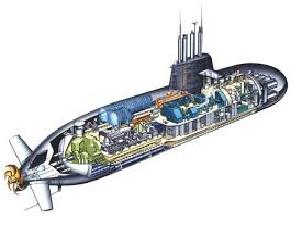 The “X” arrangement of the stern planes give the vessel the capability of operating in as little as 17 metres of water, much closer in-shore than most traditional submarines.
The “X” arrangement of the stern planes give the vessel the capability of operating in as little as 17 metres of water, much closer in-shore than most traditional submarines.
Left: German Type 212 submarine
Russia has also joined this new club with their project 877 “Varshavyanka” sub. It appears to be an improved version of the Kilo-class submarines (Project 636), deeply modernised with advanced stealth technology, and with even lower levels of noise. “Voice of Russia” unabashedly claims that Western naval experts have nicknamed the project 877 class the “black hole” precisely for its quietness (though collaborative sources have yet to be found). [2] What does seem to be the case is that the Royal Navy’s ‘rafting’ suppression techniques for propulsion systems and the rubber blocks and harmonic dampers (sometimes used in car engine bays) have been widely adopted first by the USN and then presumably via them to Russia and China (see US spy John Walker, operating between 1968 – 1985 who sold the secrets for peanuts).
Reality check
There is certainly a political undertone to the decision by Japan and the US to develop this new sub together. Both are wary of the threat of China, which announced in March it would increase its military budget for 2014 to almost $132 billion, a 12.2 % rise over last year, the New York Times reported.
If defence journals and ‘promotional’ material produced by defence contractors to would-be customers are to be believed, navies are increasingly being called on to protect shipping lanes, not just the old Freedom of navigation rights, but to provide the Right of Innocent Passage for friendly ships (for a definition of Innocent Passage see footnote). [3]
Both of these internationally accepted norms are being put in jeopardy by China’s recent belligerent behaviour in treating all of the China Sea as if it were a Chinese inland lake. It has embarked on a campaign of harassing aimed at vessels and maritime aircraft that dare to use any part of the China Sea. We can imagine China squealing the loudest if international waters around, say, Saudi, India (vital for its oil consumption) and/or California (vital for its manufactured goods) were closed to its shipping.
Blueprints have yet to be determined but it is proposed that the submarine would primarily be used for patrolling the seas around Japan looking for any potential threats (for which we can currently read China). Japan has scrambled its planes over 400 times in the past year to ward off Chinese ships circling the archipelago and Taiwan has suffered incursions for decades.
In keeping with Japan’s non-offensive military posture for troops and hardware the proposed sub is initially intended to be a purely ‘reconnaissance’, with no torpedoes or other weaponry on board capable of damaging other vessels. However, we cannot rule out future variants which may have this capability.
It is likely that the sub will be Japan’s oceanographic eyes and ears in the China Sea and surroundings, and will put it back on a par with China’s ocean floor hydrophone system (no doubt copied from the American system), circa 2012. [4]
X-Craft
Small submarines, (e.g. ‘X-craft’ from World War II) have a proven track record but none have been used in this way before. At around 30 tons and 50 feet long X-craft proved useful in sinking capital ships and 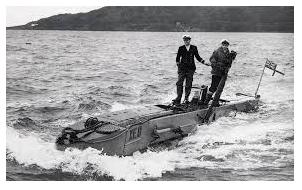 reconnaissance, de-mining and soil sampling for the 1944 D-Day landings. However their Achilles heel (in fact there were several) proved to be their lack of duration, cramp working conditions, poor sea-going capabilities and low-speed. Midget submarines such as the X-Craft, and the human torpedoes (‘Chariots’) were designed for the same purpose, the attack of enemy shipping while in harbour to render the vessels inoperable. However, midget submarines are very adept at delivering ‘swimmers’, e.g. small team of saboteurs or spies to specific points and isolated locations. Indeed, such underwater delivery of key personnel is still used today (by all accounts) by both the US and Israeli navies. A variation on the proposed Japanese-US mini-sub could very well have a compartment set aside for such swimmers. and could look like this purely fictitious illustration (below left).
reconnaissance, de-mining and soil sampling for the 1944 D-Day landings. However their Achilles heel (in fact there were several) proved to be their lack of duration, cramp working conditions, poor sea-going capabilities and low-speed. Midget submarines such as the X-Craft, and the human torpedoes (‘Chariots’) were designed for the same purpose, the attack of enemy shipping while in harbour to render the vessels inoperable. However, midget submarines are very adept at delivering ‘swimmers’, e.g. small team of saboteurs or spies to specific points and isolated locations. Indeed, such underwater delivery of key personnel is still used today (by all accounts) by both the US and Israeli navies. A variation on the proposed Japanese-US mini-sub could very well have a compartment set aside for such swimmers. and could look like this purely fictitious illustration (below left).
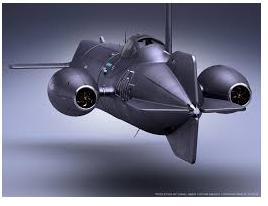 The weapons used on-board the original “X- Craft” were two side-cargoes – explosive charges held on opposite sides of the hull (each of 2 tons of amatol) with options to carry ‘limpet’ mines. Unless robotics arms are used limpet mines might not be a practical alternative but light weight torpedoes might very suit such a craft.
The weapons used on-board the original “X- Craft” were two side-cargoes – explosive charges held on opposite sides of the hull (each of 2 tons of amatol) with options to carry ‘limpet’ mines. Unless robotics arms are used limpet mines might not be a practical alternative but light weight torpedoes might very suit such a craft.
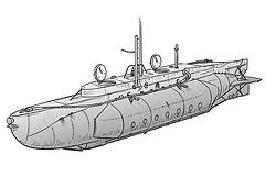 What exists today and did not in the World War II era are vital installations such as offshore oil and gas production facilities, oil and gas pipelines as well as the telephone and internet cabling – though one operation by X-Craft did cut the underwater phone cables out of Singapore and Hong Kong. [5]
What exists today and did not in the World War II era are vital installations such as offshore oil and gas production facilities, oil and gas pipelines as well as the telephone and internet cabling – though one operation by X-Craft did cut the underwater phone cables out of Singapore and Hong Kong. [5]
Right: illustration of the entire hull, with side charges, two hatches, periscope and single screw, of the original batch of X-Craft.
A maritime drone ?
Any future variant of whatever Japan and the US are now planning for an autonomous, self-regulating vessel, geared for continental shelf monitoring and in-shore surveillance, may be totally unarmed and have good hydrodynamic performance (water flow management), as its priority – but equally self-defence capabilities from predatory enemy subs and surface vessels might prove attractive if not essential.
In keeping with X-Craft being used to identify underwater and coastal defences long before D-Day and lay beacons for on-coming shipping to avoid German mines etc, a present day variant could also provide support for armed forces during amphibious operations (sometimes called “littoral” operations).
A growing recognition has certainly led to some navies re-thinking ‘engagements’ scenarios in and taking control of, the littoral environment. This is an area of maritime operation that puts warships designed for traditional ‘open water’ battles at a distinct disadvantage. So the role of existing vessels, and their size, is being reassessed. In littoral environments, battle space will be at a premium and engagements tightly compressed (possibly more complex to manage), and where timing of asset interdiction / reaction will be pivotal to an outcome. [6] The effectiveness of both E-boats and MTBs from the World War II era are perhaps illustrative of this dimension.
The depositing of 2 tons of amatol by a mini-sub against the hull of a vessel in harbour is no longer a viable sole option. Mines or missiles in the form of lightweight (or hybrid) torpedoes seem preferable. A small charge at 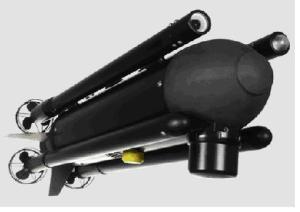 depths is all that is need to disabled even the largest of submarines. These could be carried in-board or out-board of the hull.
depths is all that is need to disabled even the largest of submarines. These could be carried in-board or out-board of the hull.
Right: Illustrating just what be carried externally
Weighing in at just 610 lbs The US Mk 54 lightweight hybrid torpedo (LHT) is not the conventional 21” torpedos but a new standard of just 12.75 inch (324 mm). Designed for anti-submarine warfare (ASW) the acoustic homing torpedo is used by the several navies including the US.
A slightly more expensive alternative would be the European MU90/IMPACT which is an advanced lightweight anti-submarine torpedo (used Germany, France, Italy, Denmark, Australia and Poland). It is designed to compete with and out-perform the US-built Mark 46 (NATO’s standard issue) in the anti- submarine role, and has also been developed in a special MU90 Hard Kill version for anti-torpedo defence (see photo below). Then there is Sting Ray, a slightly smaller, quieter, cheaper and faster option.
The actual range of the original X-Craft itself was 500 nmi (930 km) surfaced and 82 nmi (152 km) at 2 knots (3.7 km/h) submerged, though of course they could be towed thousands of miles before being activated.
The actual range of the original X-Craft itself was 500 nmi (930 km) surfaced and 82 nmi (152 km) at 2 knots (3.7 km/h) submerged, though of course they could be towed thousands of miles before being activated. But whereas the original midget submarines (the X-Craft), and Chariots (the human torpedo based on an Italian inspiration), were both designed to penetrate enemy harbour defences, to attack shipping and render target vessel(s) inoperable, the envisaged new mini-sub will be of the ‘watch and wait’ variety.
Different again will be the range of the new mini-sub. It will be able to traverse great distances using its near-endless supply of water converted into hydrogen. The quietness of such a propulsion unit will make it 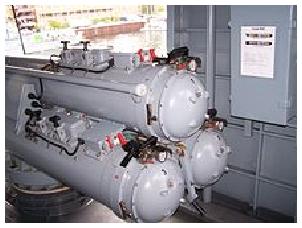 difficult to locate. With hydrogen as the fuel and no need to maintain reserves of breathable oxygen not only would the range but also the duration be many old greater that the original X-Craft.
difficult to locate. With hydrogen as the fuel and no need to maintain reserves of breathable oxygen not only would the range but also the duration be many old greater that the original X-Craft.
And whereas modern submarines have to have ‘slippery’ hull aerodynamics uppermost in the designer’s mind to achieve silence, distance and stealth, this is not so true of robotic mini-subs. Yes, they will have to be on-station as quickly as possible but the nature of their work means they will be deployed long before situations turn hot.
They can thus afford to carry munitions in-board or out-board, ie attached to the hull. These could be a single, double, or triple assembly, such as the MU90 shown above, could be fitted to the hull (assuming drag to be of secondary importance) or accommodated internally.
Prospects for political engagement
The EU foreign relations Dept published an analysis in Feb 2014 headed, “China Analysis: China’s neighbourhood policy.” In it they stated that:
- “Over the past decade, relations between China and its neighbours have undergone dramatic changes. China’s emphasis on developing a favourable regional environment has been replaced by a new kind of foreign policy: Projecting assertiveness on maritime issues and pursuing a muscular trade policy. But how do neighbours react to this new neighbourhood policy ? Is China becoming the nucleus of regional economic integration or the key player in a series of different regional conflicts ?” [7]
A singular feature of China’s foreign relationship ties is its dependence on bi-lateral treaties. With its immense size and economic performance this can only be an intimidating factor in any deal struck with a smaller power.
University of Nottingham’s ‘China Policy Institute’ (School of Contemporary Chinese Studies) has formed the opinion that “For a long time, China did not handle its relations with neighbouring countries from a regional perspective, but from a bilateral perspective.” [8] Adding that:
- “Traditionally China did not have the concept of “region”, instead it had the concept of “neighbouring areas from the perspective of Sino-centrism.”
In other words, it tends (like so many other countries) to mistakenly see itself of the centre of the universe.
However, it should be said that by the mid 1990s, China began to warm up to the idea of “region” and started placing its strategic emphasis on East Asian regional cooperation through ASEAN – though even to this day it is not an ASEAN member and is still averse to multi-lateral and regional solutions.
A huge objective of China – though it remains unstated – is that it seeks the respect and deference deserving of a major regional, if not global, power which is the status it believes it has now achieved.
Rewriting the established order.
With this mindset one suspects that the oil and gas necessities of China are driving it into the arms of confrontation. In Nov 2013 it unilaterally announced an ‘air defense identification zone’ (ADIZ) extending over the East China Sea. This gave the US and China’s neighbours an unexpected challenge to the peaceful use of international waters.[9]
The next month later (Dec 5th), China announced that its aircraft carrier, the PLAN Liaoning (formerly a Soviet built carrier) and other PLAN vessels had barred the Aegis cruiser USS Cowpens (one of the U.S. Navy’s premier surface ships), from what the spokesmen called the “inner defence layer.” [10] The USS Cowpens had, apparently, “broken into the Chinese navy’s drilling waters in the South China Sea” – island s and waters china has only recently claimed as sovereign. [11]
Prior to this, in Dec 2012, a Chinese civilian surveillance plane conducted an aerial patrol of the islands for the first time, entering what Japan regards as its air space. Japan responded by sending F-15 fighter jets to intercept the Chinese aircraft. The risk of an incident further increased in early in 2013 after China also began scrambling air force fighter jets in response to flights over the islands by Japanese aircraft.
The underlying fear is that unless halted China will be tempted to extend this ADIZ to the South China Sea and bump heads with other nations over free navigation rights. The difficulty is that the West’s allies,
e.g. Japan, South Korea, Philippines, etc all face public provocation by China in having to identify themselves to the Chinese military (at sea and in the air), in what is legally their own air space. How to handle China and keep them resorting to Putin-style tactics is the conundrum.
Although at this distance, and from our perspective, it is difficult to see China contesting areas along India’s border, that reportedly is the fear local and regional sources have articulated. For some reason the co-operation between India and the US has increased tensions with China over navigation routes in the Indian Ocean. Does China see this as a possible choke point for its imports of oil ? If so, China would be well advised to adopt or learn better ‘social skills’ and better diplomatic manners than she presently possesses if she is serious about being accepted one day as a super power.
Why China is risking all
Apart from oil and gas that would see it almost self-sufficient in fuel and guarantee its economic prosperity into the medium to distant future there seems little other driving forces for its hostile attitude towards it neighbours.
Tibet is perhaps a perfect exemplar of the Chinese government mindset when it comes to territories which others countries believe are sovereign and independent
China claimed Tibet under “Suzerainty” which occurs where a region or people is a tributary to a more powerful entity which controls its foreign affairs while allowing the tributary vassal state internal autonomy. Tibet had always kept itself isolated and independent and, in part, one can see that China may have wrongly thought this was acquiescence for its claim to and hold over Tibet.
- The dominant entity in the suzerainty relationship, or the more powerful entity itself, is called a suzerain. The term suzerainty was originally used to describe the relationship between the Ottoman Empire and its surrounding regions. It differs from sovereignty in that the tributary enjoys some (often limited) self-rule. A suzerain can also refer to a feudal lord, to whom vassals must pay tribute
This seems very much at odds with China’s democratic and communist heritage (and its public persona of friendship to adjacent countries), and it may be wrong but it does provide one rationalised and quasi legitimising view of what it is presently doing.
China claims to total sovereignty over all of the seas off its eastern coast rely purely on maps drawn up in the time of Imperial China – sometimes 500 – 900 years ago. The problems with this is that they may have been drawn to please the whims of whatever Emperor was in power and they were certainly not done in joint agreement with neighbouring states. Additionally, China has lost bits of the Empire it once had, e.g. Indo-China, and has been forced into signing treaties which limited its role from its glory days. The Communist government now wants to resurrect those ancient maps and ancient imperial claims to legitimise it claims over seas and island outcrops where oil and gas deposits now lie alluringly.
China should realise that this is as likely, and as legitimate, as Iceland giving back traditional fishing rights to British trawlers in the north Atlantic, the Egyptians handing back the Suez Canal, or the Americans complying with a British ADIZ off New York and the eastern seaboard because it was once part of Britain.
China has signed up to the UN as a full member yet wants to be treated as a ‘special case’, an exception, from its rules about ownership and use of the sea where everyone loses but China wins handsomely. This is not how a responsible member of the international community is expected to behave.
Geography of conflict
Having mapped out the separate external factors that may yet combine to create conflict and the propensity for an ensuing littoral warfare the theatre of operations are now worthy of consideration. The depth of the China Sea (being in the main a continental shelf) is similar to that of the Mediterranean Sea, i.e. around 600 feet, with the majority rarely exceeding 6,000 feet. Both have areas of shallow clear azure seas often making submarines in coastal regions visible with the naked eye from the air.
Such was the water clarity, and thus the risk of being spotted from the air even while underwater, that British submarines were painted dark blue on their upper surfaces to make them less visible from the air when submerged at periscope depth. [12]
A ‘Green-water’ navy is the term used to describe a naval force that is designed to operate in its nations littoral (coastline) zones but which also has the competency to operate in the open oceans of its surrounding region. It is a relatively new term, and has been created to better distinguish, and add nuance, between two long-standing descriptors: blue-water navy and brown-water navy (for more on brown-water / riverine warfare see https://rwhiston.wordpress.com/2010/03/18/2/).
The depiction below of an inshore cross-section is the geological difficulty China faces. Running from left to right the water deepens but only to the limited depth of the continental shelf (600 to 6,000 feet), and to the right of the illustration (not shown) are the islands and coastlines of Sarawak, Philippines, Japan, Vietnam etc.
Littoral warfare refers to the skills needed to fight a war in areas of the sea close to mainland coastlines and around islands. Both give rise to restricted and / or shallow bodies of water for manoeuvering. This type of warfare differs drastically from conventional open ocean or deep ocean naval warfare for which a ‘blue water’ navy is designed.
The main reasons are self-evident but are perhaps worth listing: [13]
- The water bodies are usually confined, such as in areas like a gulf region, or island chain etc. As a result larger vessels cannot use their speed advantage. These same larger vessels tend to have a higher centre of gravity and roll under heavy manoeuvring. As a platform they become less effective.
- Conventional large vessels have a deeper draft making then stable in most seas but unsuitable for inshore working. The shallow waters and limited space will therefore require the use of tactics which are significantly different from those of the open ocean.
- Midget submarines and quiet diesel submarines can lurk in the shallow water and hide without making noise, diesel-electric can completely shut down and sit silently on the ocean floor. If this is presently possible, how much better suited would be a robotic mini version ?
- For surface vessels, since it is close to the coast, the enemy will use fast attack boats armed with missiles (and or lightweight / fast torpedoes). The missile attacks in an Agincourt style ‘swarm’ can overwhelm even the most modern air defence systems and manoeuvring away from several torpedoes may not be possible.
Modern non-nuclear submarines are potentially stealthier than nuclear submarines; a nuclear ship’s reactor must constantly pump coolant, generating some amount of detectable noise. Non-nuclear submarines running on battery power or AIP, on the other hand, can be virtually silent.[14] Diesels electric subs were once considered too noisy and too slow but modern sound suppression systems, improved designs have resulted in the diesels being considered the deadliest submarines in littoral warfare especially because if their ability to shut down their generators and produce almost no noise. [15] They can stay ‘dead’ in the water for about a week to avoid detection and if we add in the factor of a heavier-than-water robotic unmanned sub, detection becomes even more difficult (in deep water ASW the amount of salinity can affect sonar effectiveness but this isn’t applicable in shallow waters).
Modern technology like Air Independent Propulsion System (AIPS) have enabled the diesels to do stay underwater for a period of almost a week compared to the 1-2 days underwater endurance of the non-AIPS equipped subs.
As a potential super power China in particularly vulnerable. As has been previously pointed out on this blog site it has a limited length of coastline (less than Britain’s) and all of it is girdled by a shallow continental shelf. Indeed, at the edges of that continental shelf are a necklace of island that are foreign countries and so an undetected escape into deep water by either a surface vessel or submarine is more problematical than for other powers. However, she does have one of the largest fleets of deisel-electric submarines.
End note
Submarines have long been used for spying on enemy (unfriendly) installations, intercepting radio traffic and activity in general but size and noise have always lent an element of danger to such operation. Robotic mini- subs remove many elements of the dangers posed to crewed subs. In the final analysis they are relatively disposable and offer a degree of deniability should they ever be discovered.
References:
- http://defencyclopedia.com/2014/08/17/littoral-warfare-ships-part-1-introduction/
- http://www.mbda-systems.com/mediagallery/files/maritime-superiority_brochure-1349259407.pdf
- http://rt.com/news/178936-japan-submarine-fuelcell-navy/
Footnotes:
[1] This is according to AFP, which cited the Japanese daily Yomiuri Shimbun. See also http://rt.com/news/178936-japan-submarine-fuelcell-navy/
[2] See http://voiceofrussia.com/news/2014_01_18/Russian-fleet-to-recieve-powerful-submarines-to-guard-Black-sea-and-Mediterranean-basin-7837/
[3] Innocent passage is a concept in law of the sea which allows for a vessel to pass through the territorial waters of another state subject to certain restrictions. The UN Convention on the Law of the Sea defines innocent passage as: “Passage is innocent so long as it is not prejudicial to the peace, good order or security of the coastal State. Such passage shall take place in conformity with this Convention and with other rules of international law.”
[4] It is believed that China began installing sensitive hydrophones on the floor of the China Seas (known as “fixed ocean-floor acoustic array”), in 2012, in an effort to detect and track submarines belonging to other navies. https://medium.com/war-is-boring/china-has-begun-listening-for-american-submarines-448f7e04bbe1
[5] For more background see http://www.secretscotland.org.uk/index.php/Secrets/X-Craft
[6] See http://www.mbda-systems.com/mediagallery/files/maritime-superiority_brochure-1349259407.pdf
[7] See http://www.ecfr.eu/publications/summary/china_analysis_chinas_neighbourhood_policy
[8] See www.chinapolicyinstitute.org
[9] BBC “Why China air zone raises risk” http://www.bbc.co.uk/news/world-asia-25086345
[10] See “How the US Lost the South China Sea Standoff” http://thediplomat.com/2013/12/how-the-us-lost-the-south-china-sea-standoff/
[11] The USS Cowpens incident probably took place near the Senkaku/Diaoyu islands. China’s maritime law enforcement agencies started to regularly patrol this area crossing into the UN mandated 12-nautical-mile territorial zone around the islands, with the intention of allegedly ‘protecting China’s sovereignty.’
[12] The Royal Navy, mostly operating from Malta, lost 41 submarines between 1939 and 1945. The German Navy sent 62 U-Boats into the Mediterranean, all were lost in combat or scuttled; 9 were sunk trying to get through the highly defended Straits of Gibraltar and a similar number damaged so severely they had to limp back to base (62 – 18 = 44). See http://en.wikipedia.org/wiki/Anti-submarine_warfare
[13] See http://defencyclopedia.com/2014/04/27/anti-submarine-warfare-part-2-diesel-electric-submarines/
[14] See http://en.wikipedia.org/wiki/Type_212_submarine
[15] See http://defencyclopedia.com/2014/04/27/anti-submarine-warfare-part-2-diesel-electric-submarines/
